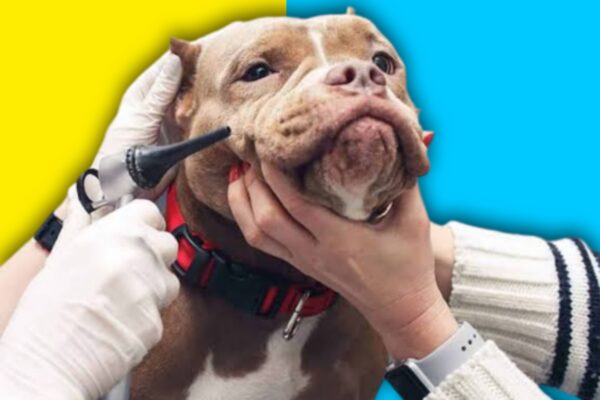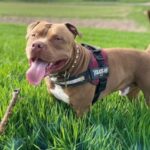
The American bully is a new breed being popularized after the United Kennel Club recognized it in 2013. Despite their terrifying appearance,these canines are known for their loving and gentle temperament. Thus, they serve as ideal family pets and apartment companions, too.
The American bully breed originated in the United States of America in 1980. American Pitbull terriers have been traced as the precursors of the American bully breed.
American Staffordshire Terriers, American Bulldogs, and English Bulldogs have also contributed to the genetics of these canines.
The major aim of breeders was to develop muscular and even-tempered dogs with impressive appearances. The American Bully Kennel Club (ABKC) recognized four varieties of American bully, namely standard, classic, pocket, and XL American bully.
Though the American bully breed enchants all the people with its friendly and outstanding personality, these canines are highly vulnerable to some of the health issues.
In this article, we will discuss in detail about american bully common health issues and how to overcome them. Moreover, we will provide tips on how to select the dogs belonging to hale and hearty bloodlines.
Here is a list of common health problems seen in American bully
- Obesity
- Hip dysplasia
- Hypothyroidism
- Allergies
- Heart disease
- Elbow dysplasia
- Eye disease
- Dental issues
- Ear infection
- Bloating
Table of Contents
- 1 1) Obesity
- 2 2) Hip dysplasia
- 3 3) Hypothyroidism
- 4 4) Allergies
- 5 5) Heart disease
- 6 6) Elbow dysplasia
- 7 7) Eye diseases
- 8 8) Dental issues
- 9 9) Ear infection
- 10 10) Bloating
- 11 Indications for the sickness or injury of your American bully
- 12 Suggestions for keeping your American bully pet free from health problems
- 13 FAQs
1) Obesity
Obesity is one of the common problems to which every heavy and bulky canine is prone. When we discuss specifically about xl bully health issues, obesity is considered to be a most common one.
Gaining excess weight is the direct outcome of an overfeeding diet and a lack of physical exercise.
So, be sure to provide a nutritionally balanced diet in moderate amounts, consistently. Their specific diet should contain a major portion of protein along with essential carbohydrates and fats to provide energy.
Taking them for short walks and calorie-burning games like fetching, hiding and seeking, etc. promotes their healthy weight and fitness. Overfeeding and over leniency both can spoil and lead to american bully flaws. Thus, stick to the daily routine, including feeding, exercises, and other activities.

Symptoms of obesity in your dog are weight gain, behavioural changes, breathing problems, mobility issues, etc. It can also lead to several severe diseases, like diabetes, heart disease, liver disease, and joint problems.
If you suspect your bully is overweight or going through the process of weight gain, then consult a vet and get recommendations for diet plans and exercises.
2) Hip dysplasia
Hip dysplasia is generally seen in bully breeds due to their massive and bulky size. Improper development or malformation of the hip joint causes mobility issues and arthritis.
Genetics is the major cause of hip dysplasia, but other environmental factors such as diet, exercise, growth rate, and muscle weight also contribute to this health condition. It results in excessive pain and discomfort for dogs.
Protein- and calcium-rich foods are to be included in their diet to promote their bone health. Avoid overexercising and keep their weight in track in order to avoid the risk of hip dysplasia.
Hobbling, difficulty in standing, unwillingness to play or jump, difficulty climbing stairs, etc. are some of the symptoms of hip dysplasia. Immediately consult a vet in case any of the above symptoms are observed. Quick and appropriate decisions may prove helpful in a permanent recovery from the disease.
Otherwise, in critical cases, there is no alternative other than hip replacement, which is found to be highly risky and expensive.
3) Hypothyroidism
Hypothyroidism is a hormonal disorder that arises due to a lack of thyroid hormone being released by the thyroid gland. American bullies and pitbulls have the tendency to suffer from this disease. Some of the symptoms of hypothyroidism are:
- Hair loss
- Weight gain
- Fatigue or exhaustion
- unable to tolerate coldness
- darkening of skin
- slow heart rate
Hypothyroidism can’t be cured, but the level of thyroid hormone can be normalised with the help of several medications.
4) Allergies
American bullies are susceptible to different sorts of allergies, like skin allergies and food allergies. These allergies are evident in the form of itchiness, redness on the skin, inflammation, dry patches on the skin, etc.
Food ingredients, mites, and some other environmental factors like air, grooming, etc. are responsible as causative agents of such allergic reactions.
Delayed diagnosis and treatment of allergies may also lead to other infections or other critical diseases. So it is crucial to consult a veterinarian and determine the real cause of the allergy.
Some canines of this breed are allergic to non-vegetarian foods like fish,beef,beef,meat etc. Such dogs should be provided with nutritional grain food, and vice versa.
Hypoallergenic foods for dogs available on the market can also be an ideal option for them. In order to reduce the risk of allergies, the following are some tips to be followed:
- Providing a premium-quality, balanced diet will improve your pet’s quality of life and immune system.
- Locate an air filter in your home. It will reduce their exposure to environmental allergens.
- Follow your pet’s grooming routine at regular intervals. This will help to remove dust and dead skin.
5) Heart disease
Inborn cardiovascular diseases, including heart failure and dilated cardiomyopathy, are found to be a common bully health issues.
Dilated cardiomyopathy (DCM) is a condition in which the chambers of the heart get enlarged, due to which muscles stretch and become thin. Hence, it influences the capacity of the heart to pump blood to the whole body.
Heart problems are chiefly congenital in such breeds of canines. Moreover, some other factors, like obesity, a lack of a balanced diet, and exercise, are also responsible for the development of heart diseases.
Possible signs of heart disease include excessive coughing, difficulty breathing, sudden weight loss, restlessness, collapse, etc. In such conditions, take your furry pet to a veterinarian and get the best advice for it.
Regular physical activity and quality diet food may improve the functioning of their heart rate and keep them healthy. Moreover, regular checkups of heart conditions are essential for discovering such issues and providing treatment at their primary stage.
6) Elbow dysplasia
Elbow dysplasia is also a developmental issue associated with joints. If three bones, namely the radius, ulna, and humerus of the elbows, are not well fitted together due to a lack of growth, then irregular pressure or weight on joint areas will result in discomfort and pain.
Among American bully breed types, pocket American bullies are highly prone to elbow dysplasia due to their more compact muscle build.
Owners of these canines are required to be watchful of their initial symptoms, such as limping or slight pain in their joints. Early diagnosis of this disease is crucial to prevent any further severe damage.
The majority of the dogs suffer from elbow and joint issues. Thus, breeders ought to focus on the genetic formation of these canines by breeding them with their healthy elbow counterparts. Environmental factors such as good exercise and a nutritional diet can improve or help avoid this condition to a certain extent.
7) Eye diseases
Most bully breeds, specifically American bully and pitbulls, are highly susceptible to eye problems. They may suffer from the following eye conditions:

Cherry eye
Dogs have a third eyelid inside the corner of their eyes. Cherry eye is a painful condition when their third eyelid pops out, giving the appearance of a red cherry. It is required to be treated immediately; otherwise, it can cause severe damage to the eye ducts and ultimately even cause dry eye.
Cataract
Cataracts are often hereditary in canines. Eyes become cloudy due to which light does not pass through the retina, leading to unclear vision and consequently blindness if left untreated.
Glaucoma
It is a painful eye disease caused by increased pressure on the eyelids. Generally, eye pressure is balanced through eye fluid, but overflowing of too much liquid exerts overpressure and damages the optical nerve and retina.
Entropion
Entropion is a condition in which the eyelid rolls inward and constant rubbing of eyelashes over the eyeballs causes irritation and pain. It may also cause corneal ulcers if not treated properly.
8) Dental issues
Dental issue is also one among american bully diseases to which they are overly prone. Even 80% of dogs suffer from different tooth diseases, like tooth decay, gum infection, and broken teeth. It begins with bacteria causing a cavity and then hardens into tartar. Consult the vet promptly about the condition before it worsens and results in permanent tooth loss.
9) Ear infection
Otitis externa is a common type of ear infection that American bully dogs are vulnerable to. This is the external part of the ear exposed to external factors.
Some discomforting symptoms of ear infections are:
- Itchiness
- Head shaking
- Liquid discharge
- Scratching at the affected area
- Redness and swelling
Bacteria, yeast, and ear mites are the various sources of ear infection. It is indeed a critical issue that may even cause deafness and facial paralysis if treatment is delayed.
10) Bloating
Bloating, also called gastric dilatation-volvulus (GDV), is a health issue common in large dogs like American bullies. It mainly occurs due to the overfeeding of canines.
Their stomachs stretch due to the gases trapped in the stomach, and pressure is applied to different organs. Hence, it may lead to fatal consequences if it does get treatment at an appropriate time.
Indications for the sickness or injury of your American bully
Being an American bully owner, it is crucial to have well-grounded knowledge about your American bully pet. You should have a decent understanding of every action and each reaction to it.
Following are the indicators that will help you determine if something goes wrong
Physical indicators
if you notice any symptoms like hobbling, difficulty in standing, sneezing, coughing, or other physical indicators of pain or discomfort in your pet, then take it to a vet right away.
Behavioural change
Changes in the behavior of your furry friend could be a possible indicator of its sickness. For example, your pet gets more inactive and dull than other days.
Appetite loss
Decreased appetite or loss of appetite can be a probable symptom of kidney disease, cancer, dental problems, or other diseases causing trouble for your pet.
Suggestions for keeping your American bully pet free from health problems
Here, we are providing you with some tips or suggestions for letting your canine lead a robust and healthy life:
- Get a proper vaccination schedule for your American bully and ensure its timely execution.
- Regular checkups may help diagnose any health-related problems at their initial stages.
- Provide a full-body exercise routine in order to strengthen their muscles and utilize energy.
- Be sure to offer your companion a healthy and nutritionally balanced diet. Avoid overfeeding or allergic food to it.
- Regular grooming and occasional bathing will maintain the hygiene and cleanliness of your pet.
FAQs
Q1. do bullies have health problems ?
Ans.Some common health issues to which American bullies prone are :
1)Obesity
2)Hip dysplasia
3)Hypothyroidism
4) Allergies
5)Heart disease
6)Elbow dysplasia
7) Eye disease
8) Dental issues
9)Ear infection
10) Bloating
Q2.Is American Bully a healthy dog?
Ans. Yes, American bullies are calm and healthy dogs but as a dog owner , you should be well aware of some health issues associated with American bully.
Q3.Do bullies have skin problems?
Ans. American bullies are vulnerable to different sorts of skin allergies. These allergies are evident in the form of itchiness, redness on the skin, inflammation, dry patches on the skin, etc.
Q4. Do bully dogs live long?
Ans. American bully can live for the average time period of 12- 14 years. Factors such as balanced diet, exercise and health care also influence the lifespan of these canines.
Hey there! I am Raj Saraf, a 23-year-old guy from India behind this awesome blog. Currently, I am pursuing my Master’s degree in English literature. Being a great admirer of this fascinating American bully dog breed, I did extensive and comprehensive research to my optimal level. During this, I got to know about some new and interesting facts about them, which encouraged me to go ahead. Moreover, I am fond of sharing my experiences and knowledge with you all! I hope you enjoy reading my blogs, and feel free to share any experiences or opinions about this amazing breed in the comments section below.










